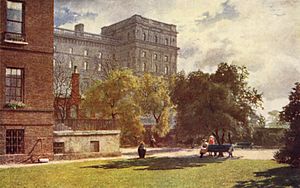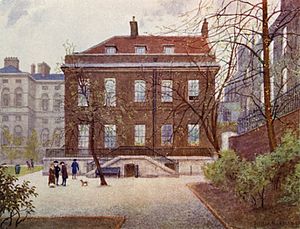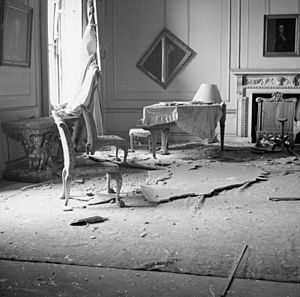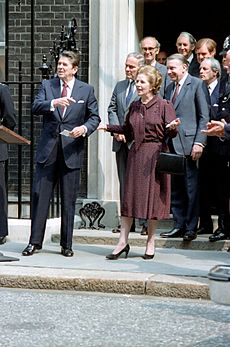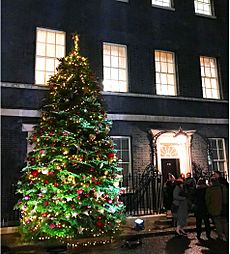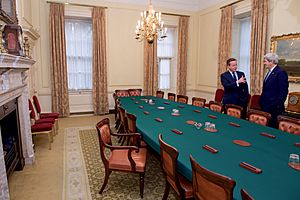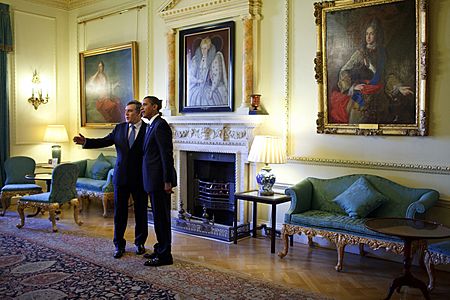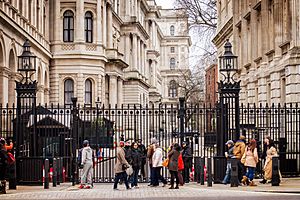10 Downing Street facts for kids
Quick facts for kids 10 Downing Street |
|
|---|---|
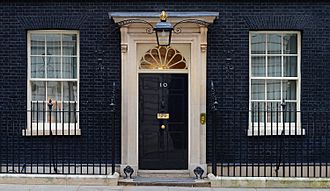 |
|
| General information | |
| Architectural style | Georgian |
| Town or city | City of Westminster London, SW1 |
| Country | United Kingdom |
| Coordinates | 51°30′12″N 0°07′39″W / 51.5033°N 0.1275°W |
| Current tenants | Rishi Sunak (Prime Minister of the United Kingdom) Larry (Chief Mouser to the Cabinet Office) |
|
Listed Building – Grade I
|
|
| Official name | 10 Downing Street, SW1A 2AA |
| Designated | 14 January 1970 |
| Reference no. | 1210759 |
| Construction started | 1682 |
| Completed | 1684 |
| Design and construction | |
| Architect | Kenton Couse |
10 Downing Street in London is a very famous building. It is the official home and office of the Prime Minister of the United Kingdom. The Prime Minister is the leader of the UK government. They are also known as the First Lord of the Treasury.
People often call it Number 10. This historic building is located on Downing Street, near Whitehall, in the City of Westminster, London. It is more than 300 years old. It has about 100 rooms inside! The Prime Minister's private home is on the third floor. There is a kitchen in the basement. Other floors have offices and rooms for meetings and special events. Here, the Prime Minister works and meets with important people. These include government ministers, leaders from other countries, and foreign visitors. Behind the house, there is a private courtyard and a terrace. This terrace looks out over a 1⁄2-acre (0.2 ha) garden. Number 10 is close to St James's Park. It is also about 3⁄4 mile (1.2 km) from Buckingham Palace, where the King lives. The Palace of Westminster, where Parliament meets, is also nearby.
Number 10 was originally three separate houses. In 1732, King George II offered it to Robert Walpole. Walpole is often called the first Prime Minister. He accepted the gift, but only if it belonged to the office of the First Lord of the Treasury. This meant that future Prime Ministers would also get to live there. Walpole hired William Kent to combine the three houses into one large building. This is the Number 10 we know today.
Even though it was big and close to Parliament, not many early Prime Ministers lived there. It was expensive to keep up and often needed repairs. Number 10 was almost torn down many times. But it survived and became a symbol of British history. In 1985, Margaret Thatcher, a former Prime Minister, said Number 10 was "one of the most precious jewels in the national heritage." It is owned by the government.
Contents
- The Story of Number 10 Downing Street
- Rooms and Special Features
- 250th Anniversary: 1985
- Security After the 1991 Bombing
- The Prime Minister's Office
- Images for kids
- See also
The Story of Number 10 Downing Street
How Number 10 Was Built
Number 10 Downing Street started as three different buildings. There was a large house called "the House at the Back." It looked over St James's Park. Behind it was a smaller town house. There was also a small cottage. The town house part gave the modern building its name. It was one of several houses built by George Downing between 1682 and 1684.
Downing was a clever businessman. He bought land south of St James's Park. This land was close to Parliament. He wanted to build a row of nice town houses. The street where he built them is now called Downing Street. The biggest of these houses became part of Number 10.
It took Downing 30 years to get permission to build. Finally, in 1682, he got approval. He built a street with two-storey houses. They had coach-houses, stables, and views of St James's Park. Over time, the house numbers changed. In 1787, what was once Number 5 became "Number 10."
Downing hired Christopher Wren to design the houses. They were built quickly and cheaply. They were on soft ground with shallow foundations. Winston Churchill later said Number 10 was "shaky and lightly built."
The street was quiet and private. An advertisement in 1720 called it "a pretty open Place." It said the houses were "fit for Persons of Honour and Quality." They had "a pleasant Prospect into St James's Park." George Downing himself never lived on Downing Street. He died in 1684, soon after the houses were finished.
The "House at the Back" Before 1733
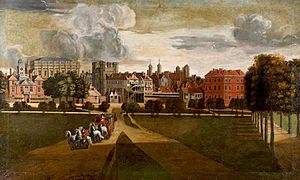
The "House at the Back" was the largest of the three houses that became Number 10. It was a big mansion built around 1530. It was next to Whitehall Palace. This house was rebuilt and changed many times. It was part of the "Cockpit Lodgings." These buildings were named after an octagonal building used for cock-fighting. Later, the Cockpit became a concert hall. Some early government meetings were held there secretly.
For many years, this house was home to Thomas Knevett. He was famous for catching Guy Fawkes in 1605. Fawkes was trying to blow up Parliament.
Members of the royal family or government often lived in the "House at the Back." Princess Elizabeth, daughter of King James I, lived there. She was the great-grandmother of King George II. King George II later gave the house to Walpole.
George Monck, 1st Duke of Albemarle lived there from 1660 to 1671. He helped bring the King back to power in 1660. He was also in charge of the Treasury. He was the first Treasury minister to live in what would become the Prime Minister's home.
Later, George Villiers, 2nd Duke of Buckingham lived there. He spent a lot of money rebuilding it. It became a large mansion with a garden view of St James's Park. After him, Lady Charlotte Fitzroy, King Charles II's daughter, moved in. The house was rebuilt again, adding a third floor. This part of the house is still the back section of Number 10 today.
The house often needed repairs because it was built on swampy ground. This caused problems until 1960. That's when Number 10 was rebuilt on strong, deep foundations.
The First Prime Minister's Home: 1733–1735
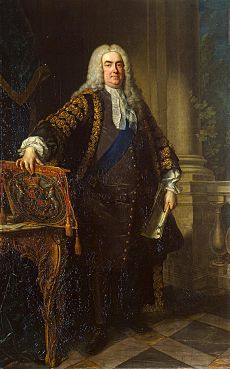
When Count Bothmer, a German minister, died in 1732, the "House at the Back" went back to the King. King George II offered it to Robert Walpole. Walpole was a very important leader. He helped the country's money and kept peace.
Walpole did not want the house for himself. He asked the King to give it to the Office of First Lord of the Treasury. This way, every future First Lord (who would usually be the Prime Minister) could live there.
To make the new house bigger, Walpole also got the small cottage next door. He hired William Kent to combine the large mansion, the town house, and the cottage. Kent built a two-storey section to connect the bigger houses. He also connected the Downing Street houses with a hallway. Kent then completely redid the inside of the building. He added a fancy top part (a pediment) to the third floor of the back house. To make it easier to get to Parliament, Kent made the Downing Street door the main entrance.
The rebuilding took three years. On September 23, 1735, the London Daily Post announced that Walpole had moved in. The cost of the work was huge, probably over £20,000.
Walpole did not use the famous black door we see today. That door was added 40 years later. Kent's door was simple. But inside, the house had 60 rooms. It had beautiful floors, fancy ceilings, and marble fireplaces. One large room was Walpole's study. It was 40 feet by 20 feet. This room later became the Cabinet Room. This is where Prime Ministers meet with their Cabinet.
Walpole also had a terrace and garden built behind his study. Official papers from 1736 confirmed that Number 10 Downing Street was "meant to be annexed & united to the Office of his Majesty's Treasury." It was to be the home for the First Commissioner of the Treasury.
Number 10 and the Treasury Building
Around the same time, William Kent also designed a new Treasury building. It was built behind Downing Street. This building was finished in 1737. It had hallways connecting it to Number 10. This allowed Walpole, who was also Chancellor of the Exchequer, easy access to the Treasury offices. The Treasury building became like an extension of Number 10. This continued until the mid-1800s. After Prime Minister Robert Peel stopped being Chancellor in 1841, a locked door was put between the buildings. This limited the Prime Minister's access to the Treasury.
A "Vast, Awkward House": 1735–1902
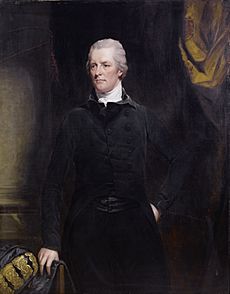
Walpole lived in Number 10 until 1742. But after him, it took 21 years for another Prime Minister to live there. Most preferred their own homes. This was common until the early 1900s. Out of 31 First Lords from 1735 to 1902, only 16 lived in Number 10.
Many Prime Ministers had bigger and better homes in London. They saw Number 10 as not very impressive. They often lent it to the Chancellor of the Exchequer or other officials.
Another reason it was not popular was that Number 10 was often falling apart. Because it was built on soft ground, floors would buckle. Walls and chimneys would crack. It needed repairs often. In 1766, the house was in bad shape. An architect said the walls were "much decayed." Floors and chimneys were "much sunk." Repairs were ordered but took many years.
Government officials complained that it cost too much to maintain. Some suggested tearing it down. In 1782, a report said the "old part of the House" was in a "dangerous state." In 1783, the Duke of Portland moved out because it needed repairs again. The cost of repairs was huge, over £11,000. People complained about the expense.
However, some Prime Ministers did enjoy living there. Lord North lived there happily from 1767 to 1782. William Pitt the Younger lived there for 20 years. This is longer than any other Prime Minister. He called it "My vast, awkward house." While there, Pitt achieved many important things.
After Pitt died in 1806, Number 10 was rarely used as the Prime Minister's home for 70 years. From 1834 to 1877, it was empty or used only for offices.
Downing Street itself became run-down in the 1800s. Other government offices moved into the nearby houses. But these houses also fell apart and were torn down. By 1857, only Number 10, Number 11 (the Chancellor's home), and Number 12 (offices) were left.
A New Era for Number 10: 1902–1960
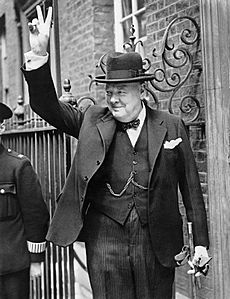
In 1902, Arthur Balfour became Prime Minister. He was already living in Number 10 as First Lord of the Treasury. Balfour brought back the tradition that Number 10 is the official home for the Prime Minister.
The building became very famous. Photography, films, and television helped link Number 10 with the Prime Minister. Pictures of Prime Ministers with important guests at the door became common. Visitors often took photos in front of the door.
Suffragettes (women fighting for the right to vote) posed there in 1913. This picture became famous worldwide. In 1931, Mahatma Gandhi posed leaving Number 10. He had met with Prime Minister Ramsay MacDonald to talk about India's independence. This photo was very important in India.
Prime Ministers also made big announcements from the front steps. Neville Chamberlain announced "Peace with honour" from Number 10 in 1938. This was after his meeting with Adolf Hitler. During World War II, Winston Churchill was often photographed leaving Number 10. He would hold up two fingers in the sign for "Victory".
However, Number 10 was damaged during the London Blitz in World War II. In February 1944, a bomb fell nearby. Some of the drawing-room windows were broken.
Number 10 also became a place for protests. Emmeline Pankhurst and other suffragette leaders protested there in 1908. People protested the Vietnam War in the 1960s. Anti-Iraq War protestors marched there in 2005.
Rebuilding Number 10: 1960–1990
By the mid-1900s, Number 10 was falling apart again. The floors were sinking. The staircase was crooked. There was a lot of dry rot (a type of fungus that destroys wood). The wooden parts of the Cabinet Room were like sawdust.
In 1958, a committee looked into the house's condition. They thought about tearing it down. But Number 10 had become a symbol of Britain. So, they decided to rebuild it. They would use as much of the original material as possible. The inside would be taken apart, photographed, and restored. A new, strong foundation would be built. Then, the original buildings would be put back together on top. Any parts that were too damaged would be copied exactly. This was a huge job. The three buildings had over 200 rooms.
The architect Raymond Erith designed this careful work. The cost was much higher than expected, almost £3,000,000. It also took nearly three years. There were delays because of worker strikes. Also, old Roman, Saxon, and medieval items were found during digging. Prime Minister Harold Macmillan lived in Admiralty House during the rebuilding.
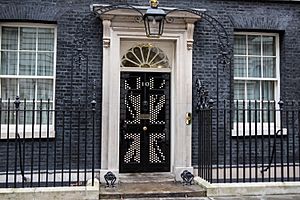
The new foundation was made of steel and concrete. The "new" Number 10 used about 60% new materials. The rest was restored or copied. Many rooms were rebuilt exactly as they were. These included the entrance hall, the stairway, the Cabinet Room, and the garden. The staircase was simplified. Steel was hidden inside columns to support floors. The upper floors were made modern. The third floor was made bigger.
When workers cleaned the outside, they found the bricks were actually yellow. The black color was from centuries of pollution. To keep the traditional black look, the cleaned yellow bricks were painted black.
Erith, the architect, was sad about the final result. He felt the government changed his design to save money. He said, "I am heart broken by the result." He felt it was a waste of money because it wasn't done "properly."
His worries were right. Within a few years, dry rot came back. More repairs were needed in the late 1960s. Even more repairs and changes were done in the 1980s. These were ordered by Margaret Thatcher.
Number 10 Today: 1990–Present
The work done in the 1960s and 1980s was the biggest recent change to Number 10. Since 1990, the house has been repaired and updated as needed. In February 1991, the IRA attacked with a mortar bomb. This caused damage to the garden and outside walls. It also led to better security. In 1993, windows were rebuilt. In 1995, computer cables were installed. In 1997, the building was changed to make more space for the Prime Minister's growing staff.
Both Tony Blair and David Cameron had large families. They chose to live in the bigger private residence above Number 11. This was instead of the smaller one above Number 10. In 2010, the Camerons updated the kitchen in Number 11. In 2020, Prime Minister Boris Johnson also updated the apartment at Number 11.
The current Prime Minister is Rishi Sunak. 10 Downing Street is home to the UK Cabinet Room. Here, Cabinet meetings happen, led by the Prime Minister. It also has the Prime Minister's Executive Office. This office handles government plans and international relations.
Rooms and Special Features
The Famous Front Door and Entrance Hall
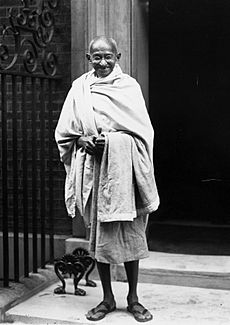
Number 10's famous door was added around 1772. It was designed by architect Kenton Couse. It looks simple and narrow. It has a single white stone step. The small, six-panelled door was originally made of black oak. It has a cream-colored frame and a round window above it. The number "10" is painted in white between the top and middle panels. The zero in "10" is painted at a strange 37-degree angle. Some think it's a capital 'O'.
A black iron knocker shaped like a lion's head is on the door. Below it is a brass letter box. It says "First Lord of the Treasury." The doorbell says "PUSH," but it's rarely used. A black iron fence with spikes runs along the front of the house. It goes up the steps to the door. The fence has a fancy archway that holds an iron gas lamp with a crown on top. The door cannot be opened from the outside. Someone inside always unlocks it.
After the IRA attack in 1991, the original oak door was replaced. The new one is made of blast-proof steel. It is so heavy that eight men are needed to lift it. The original door is now in the Churchill Museum.
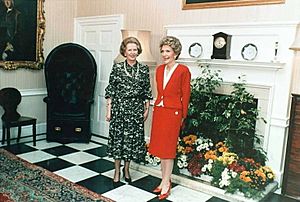
Inside the door, Couse installed black and white marble tiles. These are still there today. A special guard's chair designed by Chippendale sits in a corner. It has a "hood" to protect guards from wind and cold. It also has a drawer for hot coals to keep them warm. Scratches on the arm were made by their pistols. Number 10 Downing Street also has a lift.
The Main Staircase
When William Kent rebuilt the inside of Number 10, he created a stone staircase. It has three sections. The main part seems to float without visible supports. It has a fancy iron railing and a mahogany handrail. It goes from the garden floor to the third floor. This staircase is the first thing visitors see.
The walls along the staircase are covered with pictures. There are black and white pictures of all past Prime Ministers. They are moved around to make space for each new Prime Minister. Winston Churchill is shown in two photos. At the bottom of the stairs, there are group photos of Prime Ministers with their Cabinet members.
The Cabinet Room

In Kent's design, the Cabinet Room was a simple rectangle with big windows. It was made bigger during renovations that started in 1783. This gave it its modern look. A screen of two pairs of fancy columns was added at the entrance. These columns support the ceiling. This creates a small area before the main room. A painting called "The Palace of Whitehall" usually hangs in this small area. It also has two large bookcases. These hold the Prime Minister's library. Cabinet members often give books to this collection when they leave office.
Kent wanted this room to be the First Lord's study. But it has almost always been the Cabinet Room. Some Prime Ministers, like Stanley Baldwin, used it as their office. Others, like Tony Blair, sometimes worked at the Cabinet table. The room is painted off-white. It has large windows that go from floor to ceiling. Three brass chandeliers hang from the high ceiling.
The Cabinet table dominates the room. It was bought during the time of Prime Minister Gladstone. The modern boat-shaped top was added in the 1950s. It sits on huge original oak legs. Carved mahogany chairs surround the table. These chairs are also from Gladstone's time. The Prime Minister's chair is the only one with arms. It sits in front of the marble fireplace, facing the windows. The only picture in the room is a copy of a portrait of Robert Walpole. It hangs over the fireplace.
State Drawing Rooms
Number 10 has three connected state drawing rooms. These are the Pillared Drawing Room, the Terracotta Drawing Room, and the White Drawing Room.
The Pillared State Drawing Room
This is the largest drawing room. It was likely created in 1796. It is 37 feet (11 m) long and 28 feet (8.5 m) wide. It gets its name from the two sets of Ionic pillars at one end. Today, a portrait of Queen Elizabeth I hangs over the fireplace.
A large Persian carpet covers most of the floor. It is a copy of a 16th-century original. The carpet has a special message woven into it.
During the 1980s restoration, the fireplace was restored. It has small Ionic pillars that match the larger ones in the room. The Ionic design is also on the door frames.
The Pillared Room has few chairs and sofas. It is usually used to welcome guests before they go to the State Dining Room. But it is also used for other events that need a large space. Important international agreements have been signed here. Tony Blair hosted the England Rugby Union team here after they won the World Cup in 2003. John Logie Baird showed his invention, the television, to Ramsay MacDonald in this room. After the Apollo 11 moon landing in 1969, Harold Wilson held a party here for astronauts Neil Armstrong, Buzz Aldrin, and Michael Collins.
The Terracotta State Drawing Room
The Terracotta Room is the middle of the three drawing rooms. It was used as the dining room when Robert Walpole was Prime Minister. Its name changes depending on the color it is painted. When Margaret Thatcher became Prime Minister, it was the Blue Room. She had it redecorated and renamed the Green Room. Now, it is painted terracotta.
In the 1980s renovation, large Doric columns were added to the door frames. A big, fancy fireplace mantel was also added. It has small double Doric columns and the royal arms above. An ornate gilded ceiling was also added to make the rooms look more grand. Above the door to the Pillared Room, there is a carving of a 'thatcher' (a person who makes roofs with straw). This is a tribute to Margaret Thatcher.
The White State Drawing Room
Until the 1940s, the White State Drawing Room was used by Prime Ministers and their families for private time. Edward Heath kept his grand piano here. Today, it is often used for TV interviews. It is also a regular meeting room for Downing Street staff. This room connects to the Terracotta Room. During the 1980s reconstruction, Corinthian columns were added. Fancy ceiling designs were also added. These designs include the four national flowers of the UK: the rose (England), thistle (Scotland), daffodil (Wales), and shamrock (Northern Ireland).
The State Dining Room
In 1823, Frederick Robinson (who later became Lord Goderich) decided to build a State Dining Room for Number 10. He hired John Soane, a famous architect. The room was built between 1825 and 1826. It cost £2,000. It is a large room with oak walls and fancy moldings. Its high, arched ceiling goes up through two floors. At 42 by 26 feet (12.8 by 7.9 m), it is the biggest room in Number 10.
The room usually has a table with 20 chairs. These chairs are copies of ones made for the British Embassy in Rio de Janeiro. For bigger events, a horseshoe-shaped table is brought in. It can seat up to 65 guests. For these events, the table is set with the Silver Trust Silver set, given in the 1990s. Above the fireplace, there is a large portrait of George II. He was the king who first gave the building to the First Lord of the Treasury. Famous chefs have cooked for guests here. Tony Blair used this room for his monthly press conferences.
The Great Kitchen
The great kitchen is in the basement. It was part of the renovations that started in 1783. It is two storeys high. It has a huge arched window and a vaulted ceiling. It traditionally has a large chopping block work table in the center. This table is 14 feet (4.3 m) long, 3 feet (0.91 m) wide, and 5 inches (13 cm) thick.
Smaller Dining or Breakfast Room
Above the great kitchen, there is a Smaller Dining Room. It is sometimes called the Breakfast Room. Soane created this room. To build it, he moved the kitchen chimney. This allowed him to put a door in the room. The room has a unique feature: a window above the fireplace.
This room is cozy and comfortable. It has a flat ceiling and simple decorations. It usually has a mahogany table that seats eight people. Prime Ministers often use this room for family meals. They also use it for special guests on more personal occasions.
Terrace and Garden

The terrace and garden were built in 1736. This was soon after Walpole moved into Number 10. The terrace runs along the back of the house. It offers a full view of St James's Park. The garden has a half-acre (0.2 ha) lawn. It wraps around Numbers 10 and 11 in an L-shape.
Today, there is a flower bed around a holly tree in the center. There are also seats. Tubs of flowers line the steps from the terrace. Rose beds and shrubs are along the walls. The terrace and garden have been used for many informal gatherings. Prime Ministers meet foreign leaders, Cabinet members, and staff here. Tony Blair held a farewell party for his staff on the terrace in 2007. John Major announced his resignation as Conservative Party leader in the garden in 1995. Churchill called his secretaries the "garden girls" because their offices overlooked the garden. It was also where the first press conference for the Coalition Government was held.
Furnishings and Art
Number 10 is filled with beautiful paintings, sculptures, and furniture. Only a few items are permanent. Most are on loan from the Government Art Collection. Others are borrowed from private collectors and public galleries. These include the National Portrait Gallery and the Victoria and Albert Museum.
About a dozen paintings are changed each year. More changes happen when a new Prime Minister takes office. They often redecorate to show their own taste. Edward Heath borrowed French paintings. Margaret Thatcher wanted only British artwork. She wanted it to celebrate "British achievers." As a former chemist, she put portraits of British scientists in the Small Dining Room. In the 1990s, John Major turned an upstairs room into a small modern art gallery. He also added paintings by famous British artists like John Constable and J. M. W. Turner.
Besides art, Number 10 has many special pieces of furniture. One unique item is the Chippendale hooded guard's chair in the entrance hall. There are also old clocks. The White State Drawing Room has Adam style furniture. The Green State Drawing Room has mostly Chippendale furniture. This includes a card table that belonged to Clive of India. It also has a mahogany desk that may have belonged to William Pitt the Younger. The State Dining Room has a mahogany sideboard.
Until the late 1800s, Prime Ministers had to pay for their own furniture and decorations. This changed in 1877 when Benjamin Disraeli became Prime Minister. He insisted the government should pay for furnishings in public areas. In 1924, Prime Minister Ramsay MacDonald did not have a large art collection. He borrowed pieces from the Government Art Collection. This became the normal practice.
250th Anniversary: 1985
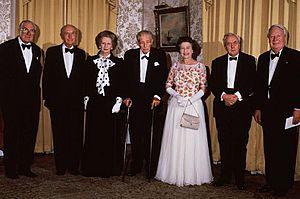
In 1985, Number 10 turned 250 years old. To celebrate, Margaret Thatcher hosted a big dinner. She invited past Prime Ministers. These included Harold Macmillan, Alec Douglas-Home, Harold Wilson, Edward Heath, and James Callaghan. Queen Elizabeth II also attended. Representatives from the families of every 20th-century Prime Minister were there too.
That same year, a book about Number 10 was published. In the book, Thatcher wrote about her feelings for the house. She said, "All Prime Ministers are intensely aware that, as tenants and stewards of No. 10 Downing Street, they have in their charge one of the most precious jewels in the nation's heritage."
Security After the 1991 Bombing
For most of its history, Number 10 was open to the public. Security was simple. Two police officers guarded it. One stood outside, and one inside to open the door. The door had no keyhole.
During Margaret Thatcher's time, threats from terrorists increased. More security was added. But on February 7, 1991, the Provisional IRA attacked. They used a mortar shell fired from a van in Whitehall. It exploded in the back garden. Prime Minister John Major was holding a Cabinet meeting inside. He moved to Admiralty House while repairs were done. This attack led to even more security. Guardhouses were added at the street ends. Other hidden measures were also put in place to make Downing Street safer.
The Prime Minister's Office
The Prime Minister's Office is inside the 10 Downing Street building. People often use "Downing Street" or "Number 10" to mean this office. It is part of the Cabinet Office. Staff here include government workers and special advisors. The highest-ranking government worker is the principal private secretary to the prime minister. This role is currently held by Elizabeth Perelman.
The office has changed over time. In 2001, it was reorganized into three main parts:
- Policy and government: This group helps the Prime Minister with advice. They also make sure government plans are carried out.
- Communication and strategy: This includes the press office, which handles media. It also has units for direct communication and research.
- Government and political relations: This part deals with party matters and local issues.
These changes were made to make the Prime Minister's office stronger. Some people have said it is becoming like a separate government department. However, experts say it is still part of the Cabinet Office. The Prime Minister does not have direct control over budgets like other government ministers.
In 2022, a report about parties during the COVID pandemic suggested changes. It said the Downing Street operation had grown too big. It needed better structure. Prime Minister Boris Johnson agreed to make the Office of the Prime Minister a government department. Staffing changes happened in February 2022. The role of Downing Street Permanent Secretary was brought back.
Current Positions in the Prime Minister's Office
Here are some of the main people working for Prime Minister Rishi Sunak:
| Position | Current holder | Term started |
|---|---|---|
| Downing Street Chief of Staff | Liam Booth-Smith | 25 October 2022 |
| Downing Street Deputy Chief of Staff (Policy) | Will Tanner | 4 November 2022 |
| Downing Street Deputy Chief of Staff (Political) | Rupert Yorke | 4 November 2022 |
| Principal Private Secretary to the Prime Minister | Elizabeth Perelman | 25 October 2022 |
| Downing Street Director of Communications | Nerissa Chesterfield | 1 September 2023 |
| Downing Street Press Secretary | Lucy Noakes | 2 September 2023 |
| Prime Minister's Official Spokesperson | Max Blain | April 2021 |
| Political Secretary to the Prime Minister | James Forsyth | 24 December 2022 |
| Downing Street Director of Policy | Eleanor Shawcross-Wolfson | 25 October 2022 |
| Downing Street Director of Legislative Affairs | Katherine Howell | 25 October 2022 |
| Parliamentary Private Secretary to the Prime Minister | Craig Williams MP | 26 October 2022 |
Images for kids
See also
 In Spanish: 10 de Downing Street para niños
In Spanish: 10 de Downing Street para niños
- Chequers – the prime minister's official country residence
- Larry – a cat employed as the Chief Mouser to the Cabinet Office at 10 Downing Street
- List of residents of 10 Downing Street
- Official residence



